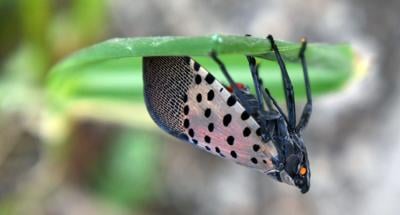Have you spotted any lanternflies recently? A more recent threat state residents have been warned about is the spread of the spotted lanternfly.
From milfoil and zebra mussels (and now quagga mussels as reported in our Monday edition) to giant hogweed and emerald ash borers, New York has seen more than its fair share of unwanted guests.
The spotted lanternfly is an invasive species from Asia that arrived in Pennsylvania in 2014 and was first spotted in New York in 2020. Currently there are known infestation sites in neighboring Erie and Monroe counties.
The insects do $324 million in damage to the agricultural industry each year, said Penn State Extension biosecurity educator Capri Stiles-Mikesell.
The state Department of Agriculture says jobs are particularly at risk in the grape, apple, hops and hardwood industries.
The lanternflies “feeds on more than 70 plant species, including maples, apple trees, grapevine and hops,” the AP says, causing potentially life-threatening damage to those trees. Their feeding causes damage including oozing sap, wilting, leaf curling and dieback. In addition, when they feed, they excrete a sugary substance called honeydew that causes black mold to grow, further damaging plants, according to the Department of Agriculture.
Swarms of the inch-long bugs may cover trees or mass in midair, and their honeydew can stick to surfaces such as playground equipment and car windshields.
At rest, adult spotted lanternflies keep their wings folded; their forewings are mostly grey with black spots, with tips bearing a pattern of small black blocks outlined in grey, according to the state Department of Agriculture. When they open their wings, the eye-catching bright red portions of their hindwings are revealed.
Adults lay dozens of eggs in clusters on trees and other hard surfaces. The clusters are about an inch long and are covered in a white, putty-like substance that eventually takes on a look similar to cracked mud, according to Penn State Extension. Over time, the covering wears away to reveal each individual egg.
Nymphs that hatch from the eggs are initially about a quarter of an inch long and have black bodies and legs with bright white spots. A late-stage nymph will grow to about half an inch long and develop a pattern of red and black stripes with white spots.
Numerous images of spotted lanternflies at each stage in their life cycle are available online, where there are also plenty of tips on fighting the insect, such as the state Department of Environmental Conservation website.
Adults should be crushed when they are seen, according to the Department of Agriculture. Egg clusters can be scraped off their surfaces, crushed and destroyed with substances such as hand sanitizer or rubbing alcohol.
Drivers should keep an eye out for spotted lanternflies clinging to their cars, too. While adults can fly, they prefer to jump or glide. They can travel long distances by latching onto cars or trains.
If you do spot the invaders, take pictures of the insect, egg masses and/or infestation signs as described above (include something for scale such as a coin or ruler) and email to spottedlanternfly@agriculture.ny.gov.




















Commented
Sorry, there are no recent results for popular commented articles.